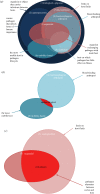What is a vector?
- PMID: 28289253
- PMCID: PMC5352812
- DOI: 10.1098/rstb.2016.0085
What is a vector?
Abstract
Many important and rapidly emerging pathogens of humans, livestock and wildlife are 'vector-borne'. However, the term 'vector' has been applied to diverse agents in a broad range of epidemiological systems. In this perspective, we briefly review some common definitions, identify the strengths and weaknesses of each and consider the functional differences between vectors and other hosts from a range of ecological, evolutionary and public health perspectives. We then consider how the use of designations can afford insights into our understanding of epidemiological and evolutionary processes that are not otherwise apparent. We conclude that from a medical and veterinary perspective, a combination of the 'haematophagous arthropod' and 'mobility' definitions is most useful because it offers important insights into contact structure and control and emphasizes the opportunities for pathogen shifts among taxonomically similar species with similar feeding modes and internal environments. From a population dynamics and evolutionary perspective, we suggest that a combination of the 'micropredator' and 'sequential' definition is most appropriate because it captures the key aspects of transmission biology and fitness consequences for the pathogen and vector itself. However, we explicitly recognize that the value of a definition always depends on the research question under study.This article is part of the themed issue 'Opening the black box: re-examining the ecology and evolution of parasite transmission'.
Keywords: arbovirus; disease ecology; host–pathogen interactions; public health; transmission; vector.
© 2017 The Authors.
Figures
References
-
- Maltezou HC, et al. 2010. Crimean–Congo hemorrhagic fever in Europe: current situation calls for preparedness. Eurosurveillance 15, 48–51. - PubMed
Publication types
MeSH terms
Grants and funding
LinkOut - more resources
Full Text Sources
Other Literature Sources


